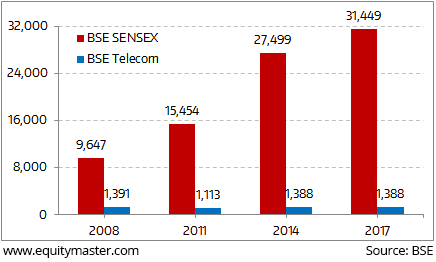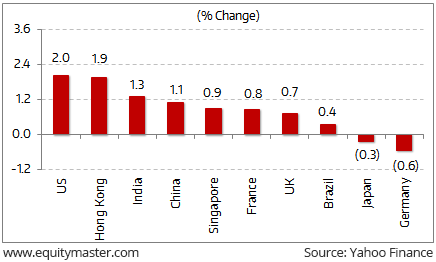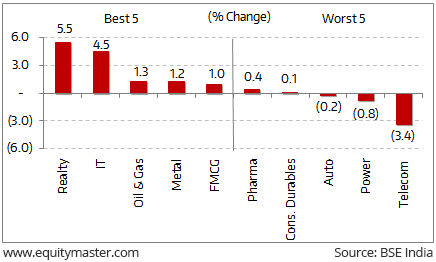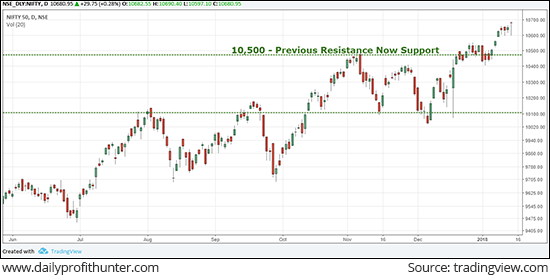Asian stock markets are lower today as Chinese and Hong Kong shares fall. The Shanghai Composite is off 0.37% while the Hang Seng is down 0.36%. The Nikkei 225 is trading down by 0.11%. US stocks closed sharply lower on Tuesday, falling for a second day as the first major sell-off of the new year intensified.
Back home, India share markets opened the day marginally lower. The BSE Sensex is trading lower by 60 points while the NSE Nifty is trading lower by 6 points. The BSE Mid Cap index and BSE Small Cap index opened the day down by 0.3% & 0.1% respectively.
Sectoral indices have opened the day on a mixed note with consumer durables stocks and information technology stocks witnessing maximum selling pressure. While, realty stocks and energy stocks have opened the day in red. The rupee is trading at 63.75 to the US$.
Airline stocks have opened the day on a mixed note with Prime Securities and Religare Enterprises being the most active stocks in this space. As per an article in a leading financial daily, more domestic airlines could show interest in Air India which is the soon to be privatized.
Reportedly, up to four Indian carriers could express interest including Jet Airways, IndiGo, SpiceJet and Vistara.
IndiGo has already shown interest in Air India privatization, while the Tata group, which runs Vistara, has said it too would like to see the terms.
As per the report, Air India’s domestic and international airline operations, including budget arm Air India Express, will sold as a single entity and units such as aircraft maintenance, catering, ground handling and hospitality to be hived off.
Further, real estate will be transferred to a special purpose vehicle and working capital debt will be restructured.
Separately, India’s air traffic is likely to cross 150 million passengers by next fiscal. Domestic traffic expected to grow by 18–20%, crossing 150 million annual passengers, with capacity growth closer to 25%. Domestic traffic will touch 125 million passengers by March 2018, and international traffic 65 million, the reports noted.
Speaking of aviation sector, 2017 had started off on a brilliant note for aviation stocks. Crude prices had crashed. And lower cost of air turbine fuel suddenly changed the economics of the aviation business. Lower costs therefore meant the possibility of the companies reporting profits at least at the operating level.
To add to that, Buffett did something in the last quarter of 2016 that Buffett aficionados would consider unimaginable. He poured upwards of US$ 2 billion a piece into the four largest US airline stocks.
The interest in aviation stocks has dimmed since then.
As per Rahul Shah, Co-head of Research, it is important to note that certain industries have relatively dull economics compared to others. And investors would do well to keep this in mind, particularly in the case of aviation. Investors need to understand the industry dynamics before buying up aviation stocks.
Moving on to the news from banking sector. Ahead of the Union Budget, State Bank of India (SBI) has raised the interest rates offered on bulk deposits above Rs 10 million by 50–140 basis points. Thus, indicating the possibility of a spike in interest rates in the banking system.
While the hike has come a week before the Reserve Bank of India is to announce monetary policy, it has not made any changes in the deposit rates offered to retail investors.
Reportedly, the rise in bond yields and the bulk deposit rates has spurred expectations that the Reserve Bank will tighten rates and the government will go for a wider deficit.
The bank would offer 6.25% on bulk deposits for one year, a rise of 100 basis points, with immediate effect. The bank has sharply raised rates for 46–210 days by 140 basis points from 4.85% from 6.25%.
With this, bulk deposit rates have been aligned with the retail rates below Rs 10 million. It will offer 5.25% for deposits between seven days to 46 days, a hike of 50 basis points. It would offer 6.25% for all deposits in the range of 46 days to 2 years and 6% for deposits between two years to 10 years.
The interest rate offered to senior citizen in the bulk deposits category has been raised by 100 basis point. The bank will offer 6.75% to senior citizens who were earlier offered 5.75% for one year to 455 days.
The urgency to raise rates comes since banks in general are selling off their excess government bond holdings to lend as deposit rates are not matching up to demand. The incremental credit till 5 January was at Rs 2.02 trillion, far outpacing the additional deposits of Rs 1.27 trillion. Between 29 September 2017 and 5 January 2018, the incremental credit of Rs 1.85 trillion was significantly higher than the accretion of deposits of Rs 0.3 trillion.
This unevenness in the demand for loans and accretion of deposits led to banks selling off their bond portfolio.
Further, the hike in bulk deposit rates has coincided with the rise in yields of government securities amid fears that the government is likely to breach the fiscal deficit target of 3.2% for FY-18.
On Monday, the 6.79% 10-year bond yield rose by 15 basis points to 7.63%, while the recently unveiled 7.17% 10-year bond yield was up 13 bps at 7.44%.

Speaking of bond yields, what is ironical is that despite a benign business environment, the bond yields in India have been ascending. Since the global financial crisis, India’s bond yields have firmed up by a whopping 1.7%, putting it in line with countries like South Africa and Russia whose economies are in a state of mess.
SBI share price opened the day up by 0.3%.
This article was originally published in English at www.equitymaster.com
Read the complete Indian stock market update. For the terms of use, go here.
Back home, India share markets opened the day marginally lower. The BSE Sensex is trading lower by 60 points while the NSE Nifty is trading lower by 6 points. The BSE Mid Cap index and BSE Small Cap index opened the day down by 0.3% & 0.1% respectively.
Sectoral indices have opened the day on a mixed note with consumer durables stocks and information technology stocks witnessing maximum selling pressure. While, realty stocks and energy stocks have opened the day in red. The rupee is trading at 63.75 to the US$.
Airline stocks have opened the day on a mixed note with Prime Securities and Religare Enterprises being the most active stocks in this space. As per an article in a leading financial daily, more domestic airlines could show interest in Air India which is the soon to be privatized.
Reportedly, up to four Indian carriers could express interest including Jet Airways, IndiGo, SpiceJet and Vistara.
IndiGo has already shown interest in Air India privatization, while the Tata group, which runs Vistara, has said it too would like to see the terms.
As per the report, Air India’s domestic and international airline operations, including budget arm Air India Express, will sold as a single entity and units such as aircraft maintenance, catering, ground handling and hospitality to be hived off.
Further, real estate will be transferred to a special purpose vehicle and working capital debt will be restructured.
Separately, India’s air traffic is likely to cross 150 million passengers by next fiscal. Domestic traffic expected to grow by 18–20%, crossing 150 million annual passengers, with capacity growth closer to 25%. Domestic traffic will touch 125 million passengers by March 2018, and international traffic 65 million, the reports noted.
Speaking of aviation sector, 2017 had started off on a brilliant note for aviation stocks. Crude prices had crashed. And lower cost of air turbine fuel suddenly changed the economics of the aviation business. Lower costs therefore meant the possibility of the companies reporting profits at least at the operating level.
To add to that, Buffett did something in the last quarter of 2016 that Buffett aficionados would consider unimaginable. He poured upwards of US$ 2 billion a piece into the four largest US airline stocks.
The interest in aviation stocks has dimmed since then.
As per Rahul Shah, Co-head of Research, it is important to note that certain industries have relatively dull economics compared to others. And investors would do well to keep this in mind, particularly in the case of aviation. Investors need to understand the industry dynamics before buying up aviation stocks.
Moving on to the news from banking sector. Ahead of the Union Budget, State Bank of India (SBI) has raised the interest rates offered on bulk deposits above Rs 10 million by 50–140 basis points. Thus, indicating the possibility of a spike in interest rates in the banking system.
While the hike has come a week before the Reserve Bank of India is to announce monetary policy, it has not made any changes in the deposit rates offered to retail investors.
Reportedly, the rise in bond yields and the bulk deposit rates has spurred expectations that the Reserve Bank will tighten rates and the government will go for a wider deficit.
The bank would offer 6.25% on bulk deposits for one year, a rise of 100 basis points, with immediate effect. The bank has sharply raised rates for 46–210 days by 140 basis points from 4.85% from 6.25%.
With this, bulk deposit rates have been aligned with the retail rates below Rs 10 million. It will offer 5.25% for deposits between seven days to 46 days, a hike of 50 basis points. It would offer 6.25% for all deposits in the range of 46 days to 2 years and 6% for deposits between two years to 10 years.
The interest rate offered to senior citizen in the bulk deposits category has been raised by 100 basis point. The bank will offer 6.75% to senior citizens who were earlier offered 5.75% for one year to 455 days.
The urgency to raise rates comes since banks in general are selling off their excess government bond holdings to lend as deposit rates are not matching up to demand. The incremental credit till 5 January was at Rs 2.02 trillion, far outpacing the additional deposits of Rs 1.27 trillion. Between 29 September 2017 and 5 January 2018, the incremental credit of Rs 1.85 trillion was significantly higher than the accretion of deposits of Rs 0.3 trillion.
This unevenness in the demand for loans and accretion of deposits led to banks selling off their bond portfolio.
Further, the hike in bulk deposit rates has coincided with the rise in yields of government securities amid fears that the government is likely to breach the fiscal deficit target of 3.2% for FY-18.
On Monday, the 6.79% 10-year bond yield rose by 15 basis points to 7.63%, while the recently unveiled 7.17% 10-year bond yield was up 13 bps at 7.44%.
The Irony of India’s Bond Market

Speaking of bond yields, what is ironical is that despite a benign business environment, the bond yields in India have been ascending. Since the global financial crisis, India’s bond yields have firmed up by a whopping 1.7%, putting it in line with countries like South Africa and Russia whose economies are in a state of mess.
SBI share price opened the day up by 0.3%.
This article was originally published in English at www.equitymaster.com
Read the complete Indian stock market update. For the terms of use, go here.




